Here it is, the post you’ve been waiting your whole life for, how to make little trees into big trees!
Or something like that.
Let me introduce the players:

The trees are acer buergerianum (trident maple). There are two different growing methods that have been employed here: one was to let them grow slow, so the nodes (the places where leaves and branches emerge from) were close together. The other method, which I’ve shown several times now, is the cd root improvement technique.
What I’m about to do now is something I read in an old bonsai magazine years ago (I can’t find the article, all those mags are print only, I can’t imagine all the knowledge that is stuffed in a box in some closet in Peoria…. which is a shame. Not only is all that info hidden away, it makes people think that the the latest hotshot bonsai artist is a genius when he shows his “new” technique he found in an old mag). The article was either written by Suthin Sukosolvisit or was just chronicling a technique he was using. Since its been so long since I read the article, and I can’t remember the details, I am improvising the technique (and doing a real ham-handed job of it too). But I do know one thing, trident maples will fuse trunks. I would even suggest they fuse and graft better than any other tree, even ficus.
First things first into this hand dirtying exercise: rootwork-
 This tree is one with a cd under it. I chose it because the roots didn’t develop on one side.
This tree is one with a cd under it. I chose it because the roots didn’t develop on one side.
 This gives me a spot to shove the 2nd and 3rd trees into place.
This gives me a spot to shove the 2nd and 3rd trees into place.
I remove the roots on the bottom of the cd.
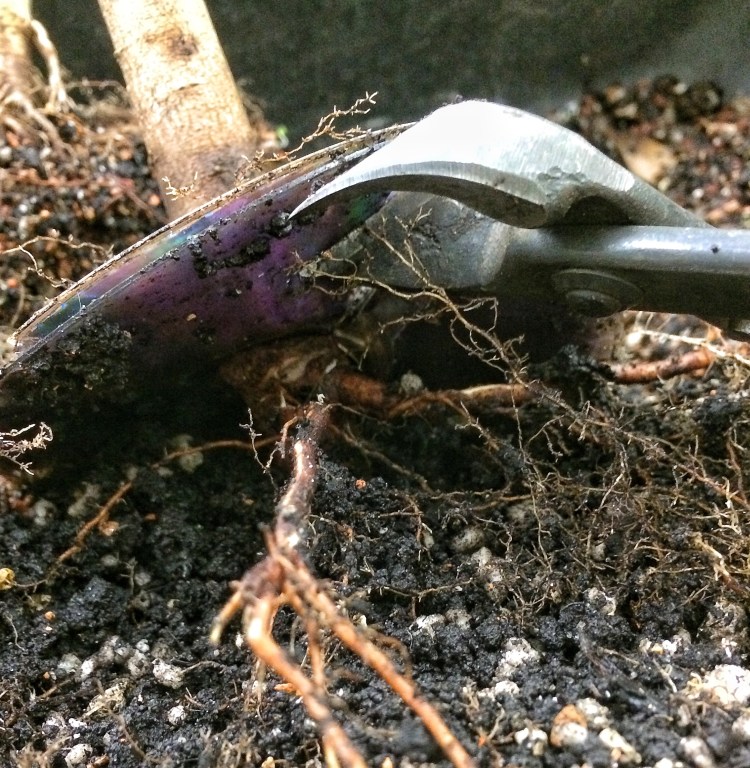
 And now I’m ready for the other trees.
And now I’m ready for the other trees.
 The smaller trees were also chosen because they had weaker roots on one side.
The smaller trees were also chosen because they had weaker roots on one side.
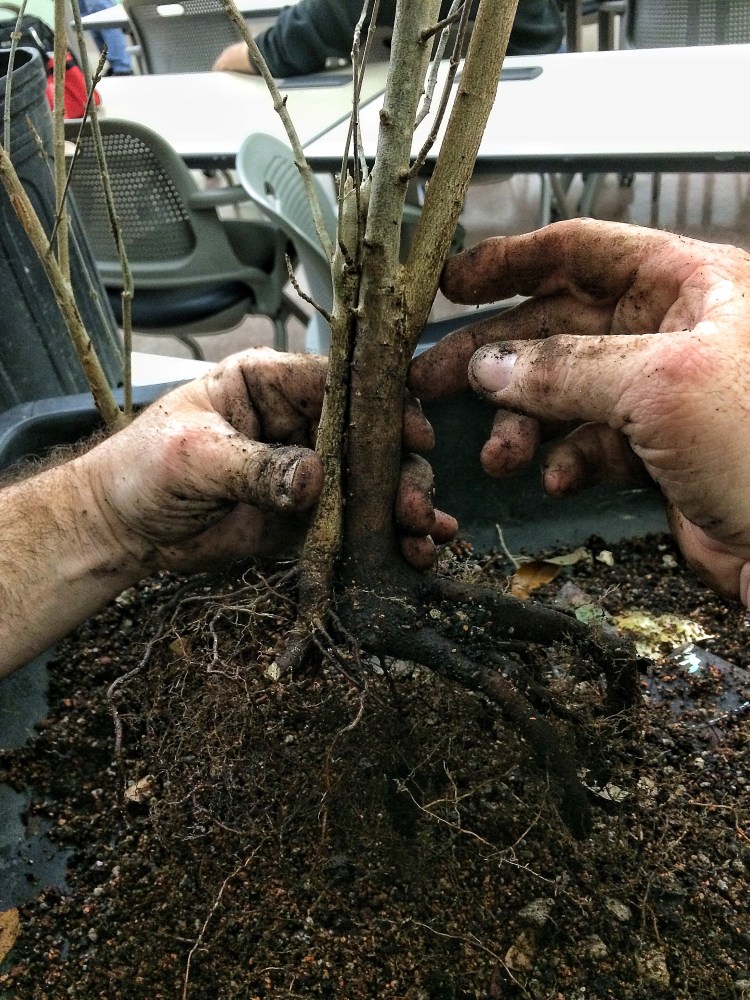
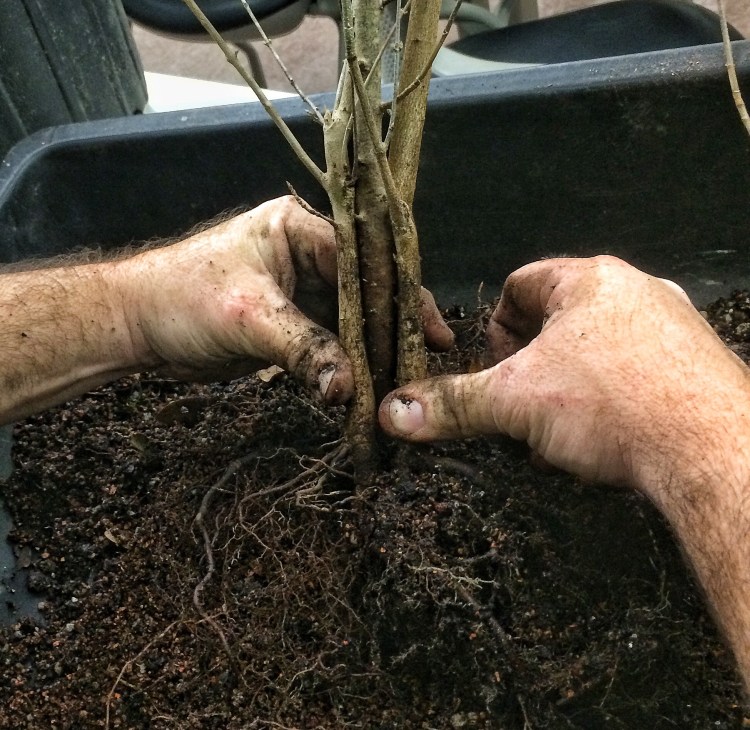 I also tried to match up the shapes of the trunks. I didn’t do so well with that. It’s ok, as they grow larger, they’ll meld together. I scored the bark where the trunks are touching so they will grow together quicker.
I also tried to match up the shapes of the trunks. I didn’t do so well with that. It’s ok, as they grow larger, they’ll meld together. I scored the bark where the trunks are touching so they will grow together quicker.

 And the next step is to tape the trees together. There is such a thing as “grafting tape” but, since I’m doing this by the seat of my pants, I don’t have any.
And the next step is to tape the trees together. There is such a thing as “grafting tape” but, since I’m doing this by the seat of my pants, I don’t have any.
I do, however, have that roll of self-amalgamating tape from the juniper post I did last year (the one with all the crazy trunk bending where I used it instead of raffia).

Self-amalgamating tape is an electrical tape that only sticks to itself. I think it would be perfect for this.

Well, it would be if it still worked.
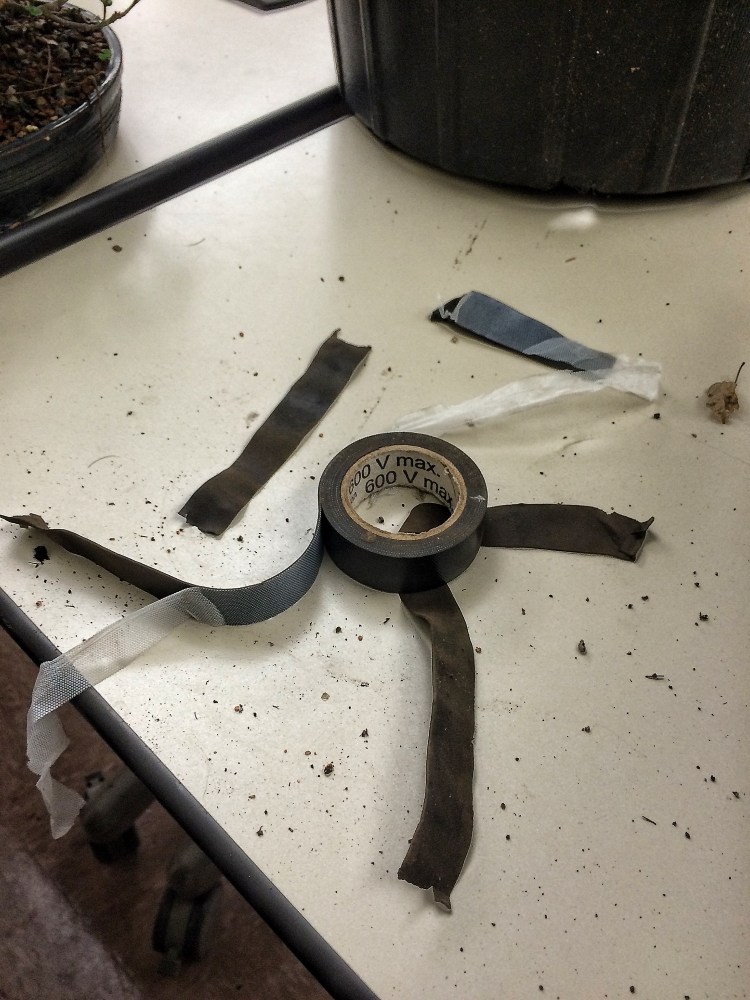 I guess there’s an expiry on it. It won’t stick anymore. Dammit.
I guess there’s an expiry on it. It won’t stick anymore. Dammit.
I do have regular electrical tape, I’ll take any port in a storm, I guess.

It’ll work.
Basically the trees need to be kept in contact until they fuse. Grafting tape is designed to be rigid enough for the job (as is electrical tape, I hope) yet it will give and flex when the trees grow.
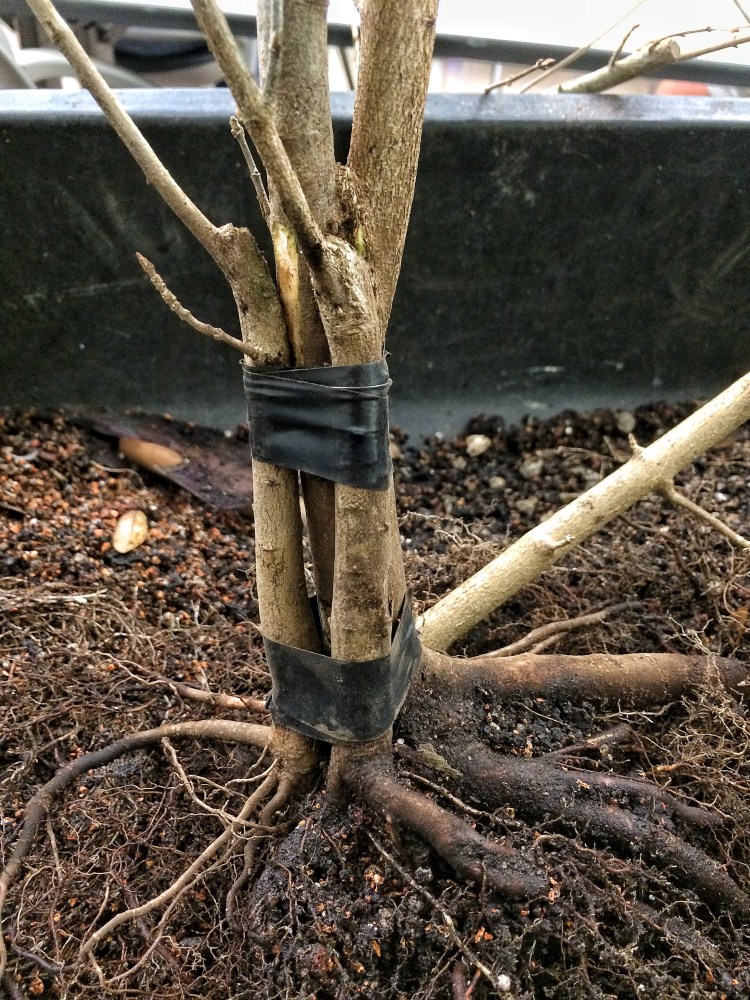
Now, a little cut paste so those cuts don’t dry out.
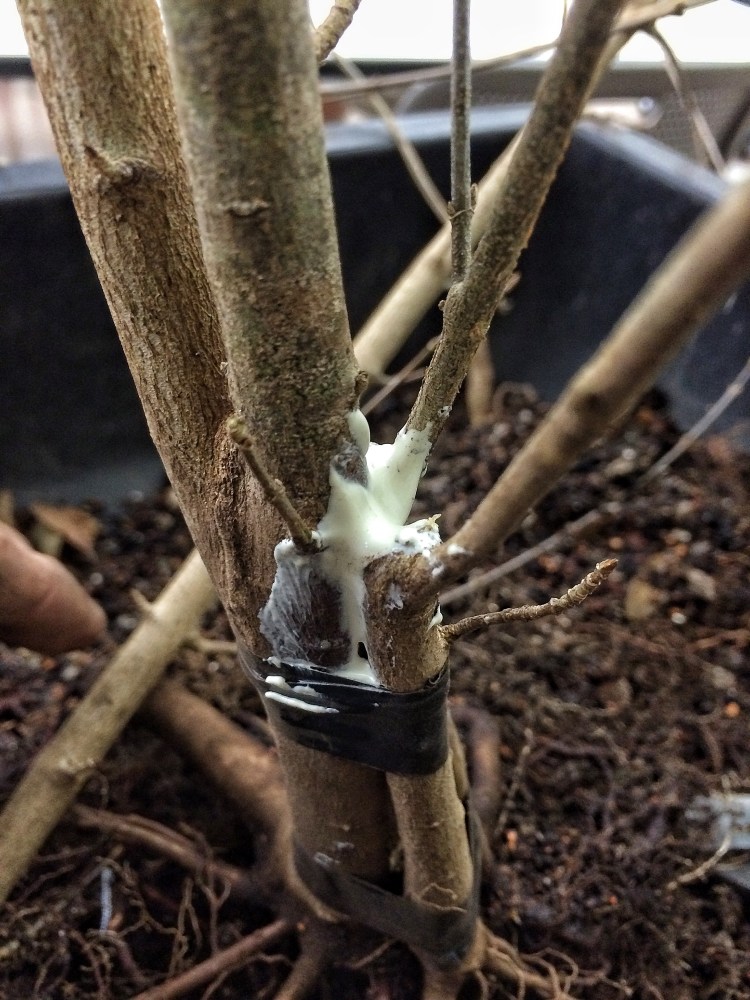
And it’s ready for a pot.
Here’s a cool tip: you know how, when you cut down a regular nursery pot…..
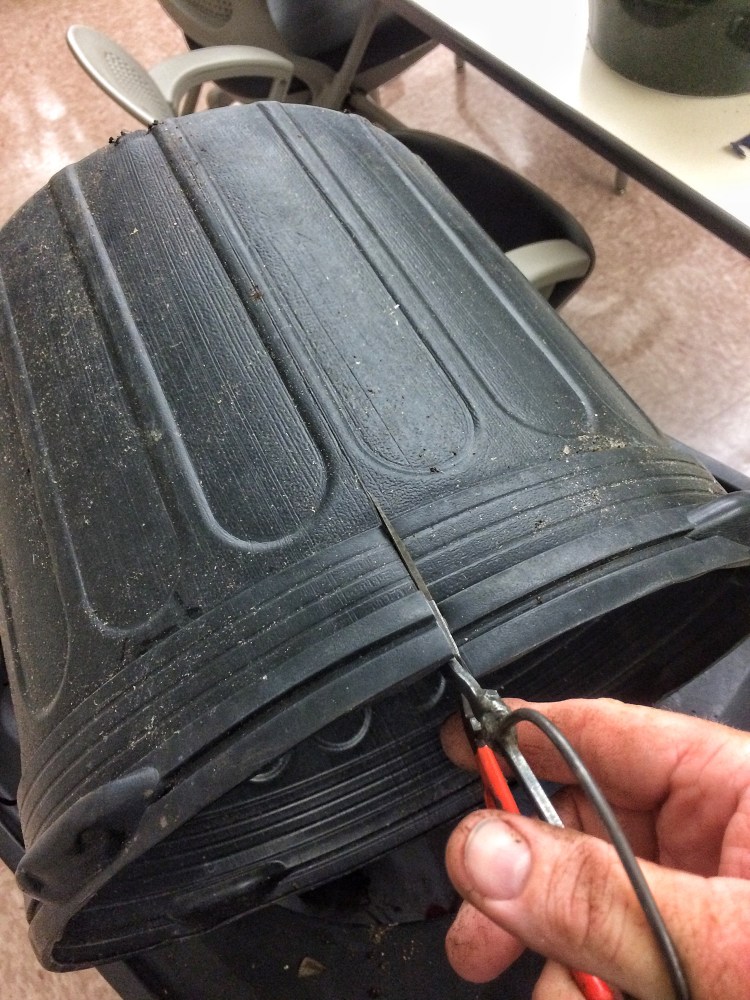
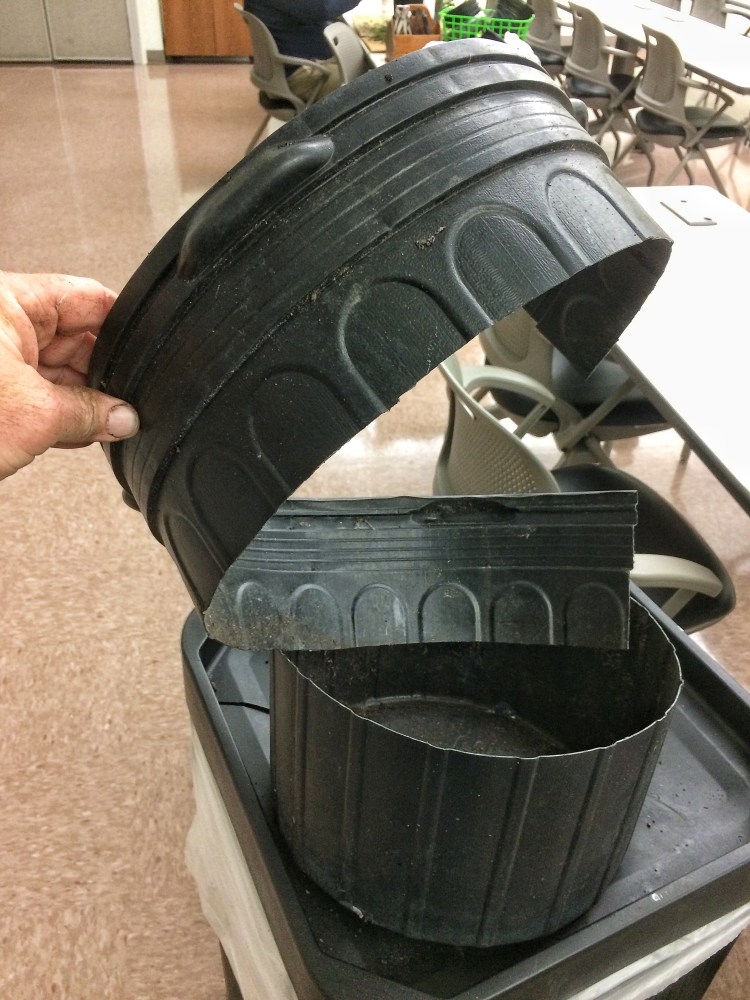
……you end up with a floppy, hard to pick up pot because the lip (which is structurally important) is now gone?
How’s do you like this?
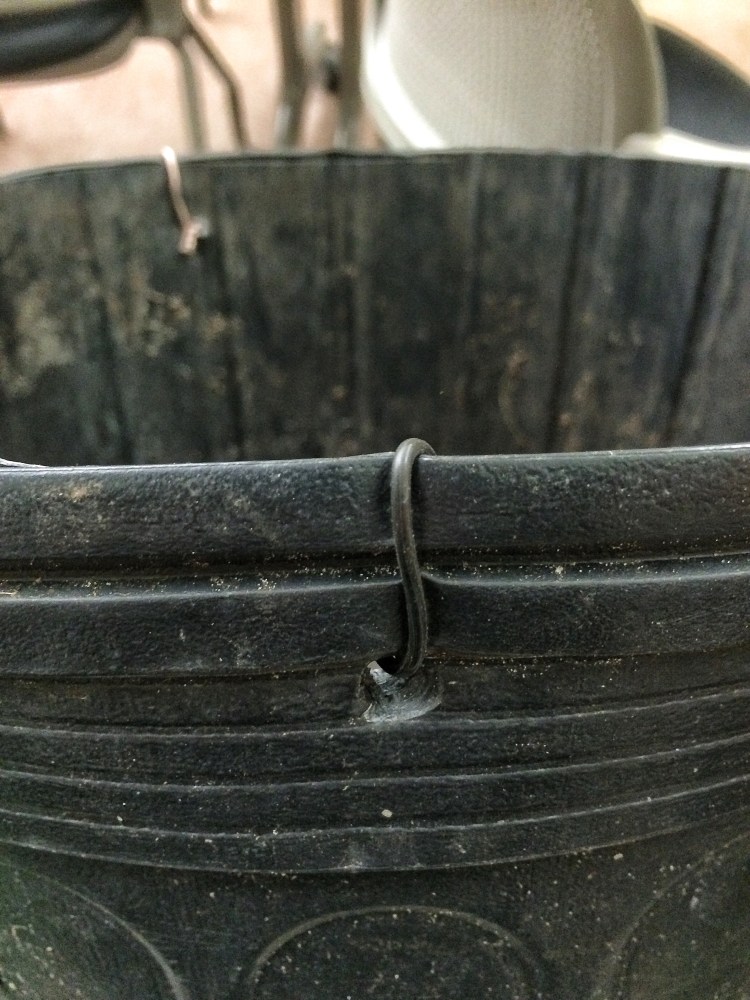 Take the lip, poke some holes and viola!
Take the lip, poke some holes and viola!

(You know, I’m still waiting for someone to call me out on my use of the word “viola!”)
Nifty, right? As with all good ideas, I stole it (maybe I got it, too, out of an old bonsai mag).
Anyway, I’m using a mix of nursery soil (half perlite, half standard potting soil) and my bonsai mix. And I’m fertilizing heavily; I want the trees to get as tall and to grow as much as it it can.
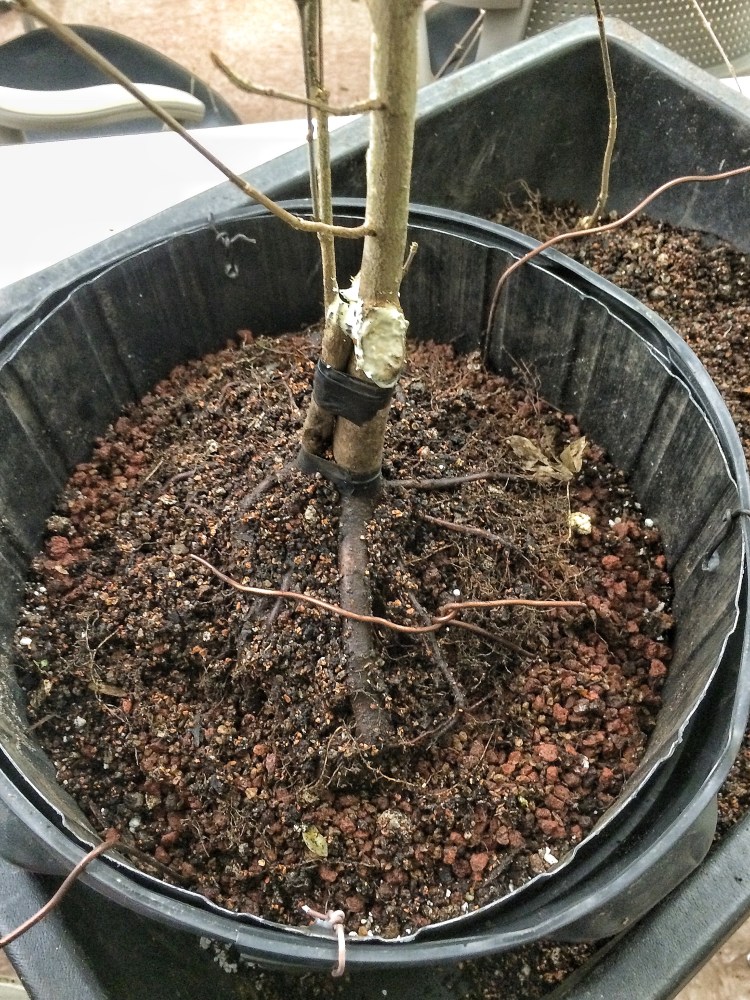

And, again, viola!
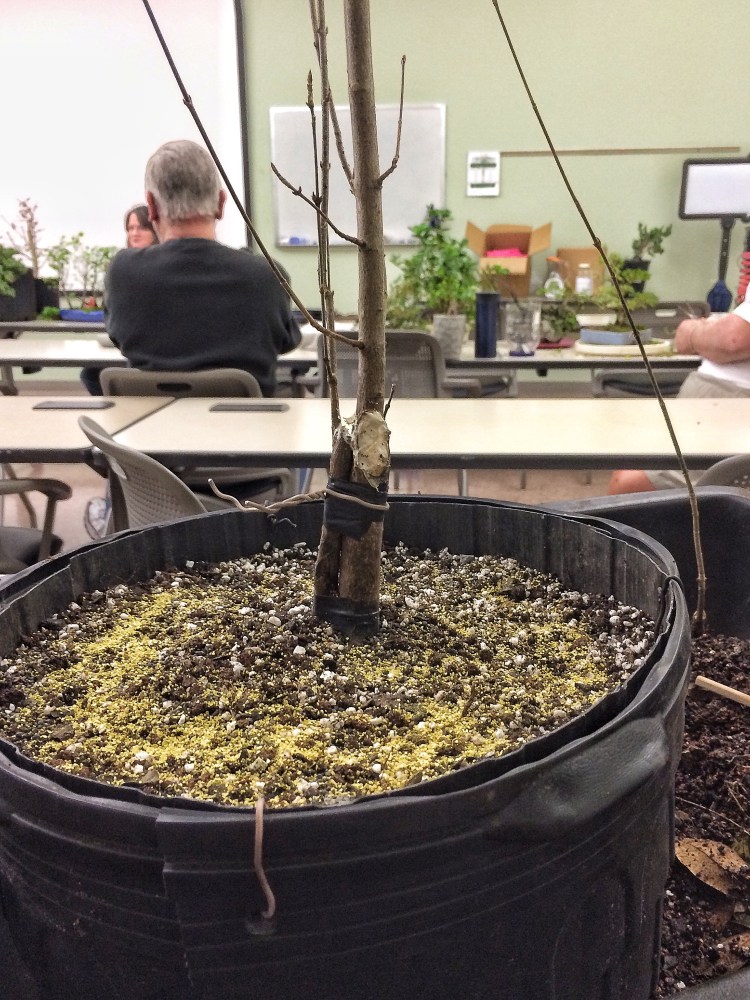 The yellow stuff, for those who are asking, is a pre-emergent weed preventer (much like Preen, but I use Oh2). It is a fantastic idea to stop weeds before you get them.
The yellow stuff, for those who are asking, is a pre-emergent weed preventer (much like Preen, but I use Oh2). It is a fantastic idea to stop weeds before you get them.
I did one more (hopefully) fusion, this time with only two trees.

I achieved better trunk contact with this one. We shall see what happens and I’ll update as needed.
Oh…..to answer the question before it’s asked, why would anyone bother doing this instead of putting the tree in the ground and growing it out? In Florida, I could get the trunk just as fat in a year if I field grew them. I will, by the way, but the reason to do this is to give the trunks more character to begin with. If you grow it out you end up with a straight, smooth, telephone pole. This way there will be fissures and muscling in a shohin sized tree from the beginning of the styling process.
And those roots! There are lots of roots radially arranged around the trunk now.

Do you say ‘Voila’ and spell viola and still mean ‘there it is!’ or do you really mean the musical instrument or little flower???
LikeLike
You know Ed, I’ve been using it here all year and no one has noticed it.
This is how I say it in my head: imagine a heavy southern American accent (maybe even Texan) and say it like “vye-ohhhhhhhhhhh-laaaaaa”.
But I mean “that’s it” – the French word is “voila” pronounced “Vwah-laaa”
LikeLike
Adam – try just piercing the pot and cutting around instead of cutting a slot and then around. the bottom now fits into the top with no hassle of the slit making a weak side. It works on most of my nursery pots.
LikeLike
Reblogged this on Wolf's Birding and Bonsai Blog and commented:
New post by my favorite bonsai blogger.
LikeLike
For fast growth you used perlite, bonsai soil, and potting mix, so could I use a mix like perlite, turface, and sifted potting soil (inexpensive items available to me currently) for trees in training pots that need to get good branch growth, but still develop some ramification?
LikeLike
Yes indeed. That mix is a good one
LikeLike
You mentioned about heavy fertilization ….. could you elaborate it … like stage after repotting, contents of fertilizer, organic or inorganic and frequency
LikeLike
Sorry, I talk about what I use so much in other posts. The brand is Milorganite. I used two big handfuls-it’s an organically derived fertilizer that won’t burn. I put it on right then and will reapply probably every two months or so.
LikeLike
Reblogged this on Scratch Bonsai and commented:
Great post and very informative
LikeLike
What ratio of potting soil / perlite to are you using? I’m interested in a lighter, more affordable substrate for growing out nursery stock, but I’m concerned with too much moisture retention with the potting soil.
I’m currently using 1:1:1 pine bark, granite grit, turface for my trees. I’d love to just use a perlite, potting soil and turface mix for collected trees that aren’t ready for bonsai pots yet – would a 1:1:1 mix with that be too moisture retentive?
LikeLike
If I’m making a regular potting soil for growing I’ll buy a high quality kind (like Miracle gro) and use half that, half perlite. Often I put used bonsai soil in my mix too.
I think your mix sounds ideal except I’d put 2 parts perlite.
LikeLike
I have two Bougainvillea pieces cut from a big plant and they are both starting to put out new growth. Could I use this technique to tie them together to create one trunk with more character?
LikeLike
They will fuse to a degree, but not as well as tridents. I’ve dug up old trunks that were made up of multiple stems and when one dies back it is definitely not fused as a solid piece.
LikeLike
Thanks!
LikeLike
hi adam.. can you update the progression from this fusing project.?
LikeLike
It’s still alive. I haven’t looked at it to actually see the progress yet. Maybe in January I’ll revisit it
LikeLike
I’m very interested in an update of your fusion! I want to make my own with punicum granatum or with ficus. Greetings from switzerland
LikeLike
The trees are fused where I made the cuts but they haven’t grown much beyond that. I’m guessing they may need to go in the ground for a few years for them to look like a single tree.
The trick is to have full contact and a tight wrap to keep the trees pushing against each other
LikeLike
Could you use this same method to join and get early trunk twist with a live oak and basswood (linden) sapling?
LikeLike
I think you could, it doesn’t hurt to try
LikeLike
What happened to all these?
LikeLike
Just sitting in my nursery. I have too many clients trees to work on and too many projects
LikeLiked by 1 person